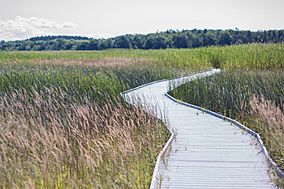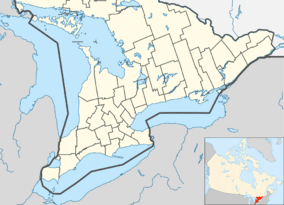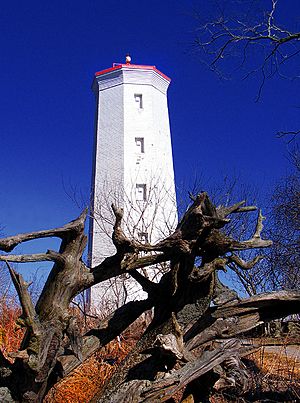Presqu'ile Provincial Park facts for kids
Quick facts for kids Presqu'ile Provincial Park |
|
|---|---|
|
IUCN Category II (National Park)
|
|

Presqu'ile Marsh
|
|
| Location | Northumberland County, Ontario |
| Nearest city | Brighton, Ontario |
| Area | 9.37 km2 (3.62 sq mi) |
| Established | 1922 |
| Governing body | Ontario Parks |
Presqu'ile Provincial Park is a beautiful park located in southeastern Northumberland County, right on the north shore of Lake Ontario. It's close to the town of Brighton in Ontario, Canada. The park covers about 9.37 square kilometers (3.62 square miles). Its name, "Presqu'ile," comes from a French phrase meaning "almost island." This name was likely given by Samuel de Champlain during one of his early trips. The land itself is a peninsula that formed when a limestone island connected to the mainland by a sandy strip of land. This type of landform is called a tombolo.
Contents
Amazing Nature and Wildlife
Presqu'ile Provincial Park is home to some really special natural areas. Its wetlands are among the largest along the northern shore of Lake Ontario. These wetlands have many sand ridges running through them, which creates different kinds of homes for plants and animals. The mix of sand dunes, marshes, and forests means there's a huge variety of plants here.
Unique Plant Life
The park's plant life is quite similar to the larger sand spit at Long Point. The long sandy areas at Presqu'ile create natural changes in vegetation. You can find everything from sand dunes to thick forests. Sand dunes and special wet sandy areas called "pannes" are rare along Lake Ontario's north shore. Pannes are unusual places with moist, sandy soil that gets flooded sometimes. They are like wet prairies or meadows and have many different plants.
Some unique plants found in the pannes include Carex aurea, Cladium mariscoides, Scleria verticillata, Parnassia glauca, and Physostegia virginiana. If you see the bright pink flowers of Physostegia in summer, you know you're in a panne! These special wetlands are important for scientists studying plant diversity.
Bird Migration and Habitats
Presqu'ile's location on Lake Ontario makes it a perfect resting spot for birds traveling along the Michigan Flyway. This means it's an amazing place to watch migrating birds and even monarch butterflies. The park's long beaches are especially popular with migrating shorebirds.
Nearby limestone islands are home to large groups of nesting birds. You can see double-crested cormorants, Caspian and common terns, and several types of gulls. Also, great blue herons, great egrets, and black-crowned night-herons nest here. In early spring, Presqu'ile Bay fills with thousands of migrating waterfowl.
The park also has a large marsh where rails, bitterns, and other wetland birds build their nests. There are also forests and open fields, offering many different habitats in one small park. Presqu'ile is recognized as a Canadian Important Bird Area. Overall, this small park has seven distinct natural areas.
White-tailed Deer Impact
The park has a good number of white-tailed deer. While they are part of the park's wildlife, their grazing (eating plants) can cause problems. They eat many native plants, which makes it harder for new trees to grow.
A Look Back in Time
The area where the park is now was chosen in 1797 to be a town called Newcastle. It was meant to be the main town for the county. However, on October 8, 1804, a schooner named HMS Speedy sank offshore. This ship was carrying important officials to a trial at the new courthouse. Everyone on board was lost, and the ship was never found. Because of this tragedy, the county's main town was moved to nearby Amherst (now Cobourg, Ontario).
The Historic Lighthouse
In 1840, a lighthouse was finished at Presqu'ile Point. The person who designed this 69-foot, eight-sided building was Nicol Hugh Baird. He also designed other important waterways like the Murray Canal and parts of the Trent-Severn Waterway and the Rideau Canal. Today, this lighthouse is the second oldest working lighthouse on the north shore of Lake Ontario.
Park Development Over Time
In 1922, a special group was given permission to create a park at Presqu'ile. In the 20th century, Presqu'ile became a popular spot for fun and relaxation. It had two kilometers of sandy beaches, a summer hotel, and even a dance hall. There was also an annual boat race and a nine-hole golf course. As years passed, how people enjoyed the park changed. The golf course was removed, and the hotel and dance hall closed. In 1954, Presqu'ile became part of the Ontario Parks system. Since then, it has been a favorite place for campers, nature lovers, and many other visitors.
Fun Activities and Facilities
Presqu'ile Provincial Park offers many things to do for families and visitors. It has 397 campsites, areas for day use, a beautiful beach, a store, and two visitor centres. The park focuses on family fun and has a special program called Natural Heritage Education. This program teaches visitors about the park's nature and history.
The park often hosts special events throughout the year. These include Waterfowl Weekend in March, History Weekend in August, Parks Day, and Canada Day celebrations. Popular activities at Presqu'ile include cycling, swimming, paddling, fishing, hiking, and watching wildlife.



